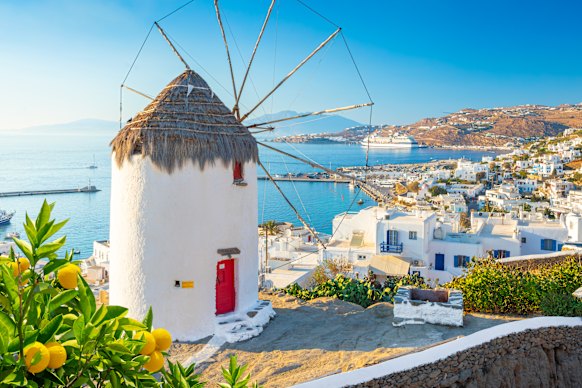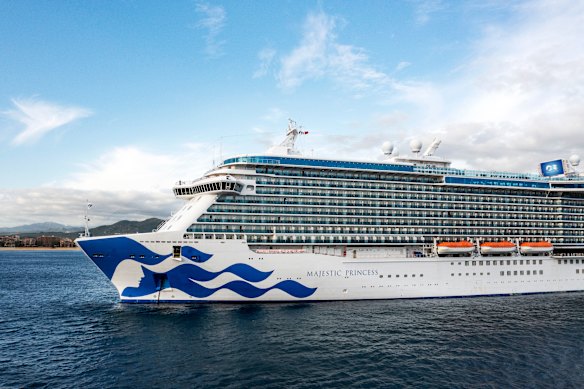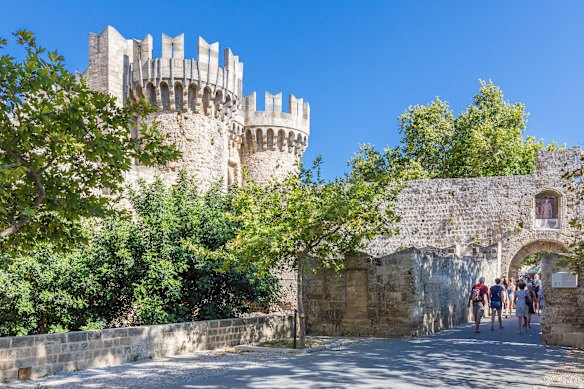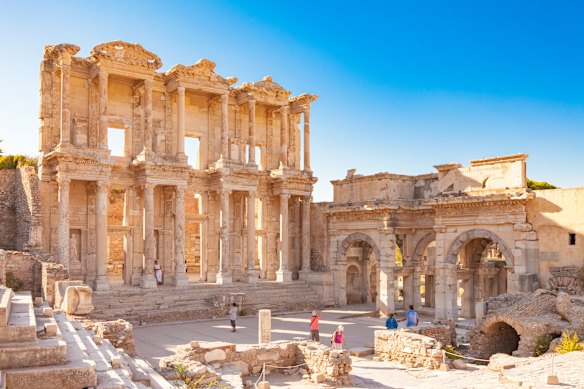My first time on a big ship taught me a big lesson
Under the bluest of skies, a sun-roasted middle-aged man works on completing the Greekest of scenes, dutifully applying whitewash to the walls of his house.
On Mykonos, the party island of the Cyclades, this is not a rare sight. According to our guide, Nikos, the buildings are painted four times a year. But there’s a bleak secret behind the dazzlingly distinctive look.

Panoramic view of Mykonos town.Credit: Getty Images
“They were whitewashed for sanitation after a cholera outbreak,” Nikos says of the 1938 government directive that accidentally gave the Greek Islands their signature look.
As a novice on my first big-ship cruise around the Mediterranean, this new knowledge is a major part of the appeal. The 10-day jaunt aboard the Majestic Princess visits several places I’ve never been to before, many of which I’ve fancied a nosy around for years.
That’s as good an excuse as any to break the duck. However, working out the best way to see the destinations is a process of trial and error.
On Mykonos, it’s in a big tour group with Nikos as our funny, engaging guide. He tells tales of a pirate who was spared execution and became the island’s most beloved baker, then points out the supposed meanings of different roof colours. Blue roofs indicate those who work at sea, green roofs those who work on the land, and the red roofs for miscellaneous others.
However, the limitations of steering a 45-strong group through the narrow lanes of Mykonos’ main town become quickly apparent. It was designed to be deliberately confusing to potential invaders, but has the unfortunate side effect of being equally confusing to hapless, friendly visitors. Getting lost is part of the fun, right?
Once the accidental splinter groups are herded back together, the walking tour becomes a bus tour. The maze is left behind for the strikingly clear waters and merry windsurfers of Kalafatis Beach on the other side of the island, before a peek at the phenomenally intricate altarpiece of the Panagia Tourliani Monastery.
Once back on board, it’s time to properly explore the ship. The 330-metre-long Majestic Princess was originally designed for the Asian market, and based in Shanghai. A recent multimillion-dollar refit has seen the ship made over to better suit Western tastes. In has come O’Malley’s Irish pub, where folk duos get the late-night crowd stomping their feet and banging tables. Speciality restaurants have changed identity, too, notably with the Harmony Asian restaurant being replaced by upscale Italian fare at Sabatini’s.
Some traces of the former incarnation remain – signs in the bathrooms still have Mandarin translations, for example. The overall vibe, though, has loosened a top button to reach a happy balance of reserved and relaxed. It never skims too close to raucous party boat or fusty atmosphere vacuum.
It’s an enormous operation – they get through 480 dozen eggs and 200 kilograms of tomato sauce a day – but one where you rarely spot the seams. Immigration paperwork is done for passengers, so there’s no lengthy waiting at border controls, and billing everything back to the cabin means there’s no need to carry a wallet around.

Majestic Princess has capacity for 3560 passengers.Credit:
Most impressively, the Majestic Princess seldom feels crowded, even at full-3560-passenger capacity. There are enough places to eat, drink, watch shows and chill out for everyone to find their own favoured hang-out, whether zapping video game monsters in the teens club, completing Sudokus under the clear roof by the indoor pool or watching Mamma Mia on the giant screen above the lido deck.
Other pleasant surprises include the uncramped cabins and the food – generally a couple of levels above mass catering expectation, even in the sprawling buffet and especially so with the plump crab cakes at The Catch by Rudi.
Where the size of the ship is truly noticeable, however, is in port. It makes ferries and superyachts look like ants, and the effect of a couple of thousand people disembarking at once is hard to ignore. Rhodes, however, absorbs the influx better than Mykonos.
The second stop on the journey around the Mediterranean has a vastly different vibe to the first. Rhodes is all about knights, rather than nights out, and the city walls are an easy walk from the port.

The Palace of the Grand Master of Knights, Rhodes.Credit: iStock
This is the clue to explore the atmospheric medieval streets independently rather than on a tour. Ambling between the shops is a low intensity delight, and eventually leads to the Palace of the Grand Master of the Knights of Rhodes. In the 14th century, the Knights Hospitaller took over and beefed up this once-Byzantine fortress. They stayed until 1522, when the Ottoman Empire conquered Rhodes, and the knights scurried off to Malta.
The Palace is a handsome, redoubtable building, with giant stone staircases, centuries-old floor mosaics and interior vaulted roofs. It serves as a museum about the island and the knights, which is at its best when it switches from old stuff in glass cases to telling derring-do stories about various sieges.
The entrance to the city walls is just outside the palace, with about a kilometre of ramparts open for strolling. This makes for a photogenic walk back to the ship, with views over lemon-tree-studded gardens and terracotta tiles. The mix of steeples, minarets and domes gives a visual snapshot of Rhodes’ complex history.
In Turkey, however, there’s a chance to go back further in time, to the ancient Greek and Roman empires in Ephesus.
These are also the ports where organised shore excursions come into their own – the hassle of organising transport and fear of not getting back to the ship in time are removed.
This time, I pick the small group option. There are 14 of us, which pushes the boundaries of “small group” somewhat, and it makes little practical difference at the House of the Virgin Mary in Selcuk.
This shrine, on the site of where Jesus’ mother supposedly lived out her final years, is furiously busy with Catholic pilgrims year-round. A big queue slowly snakes through, with a few seconds in the house, most people quietly wondering what the fuss is about.
But at the main stop, the extraordinarily expansive ruins of Ephesus, being in a smaller group pays dividends. It’s possible to huddle around the guide as she explains the temples, public baths, theatres and markets, without having to rely on crackling earpieces.

The Library of Celsus, Ephesus.Credit: iStock
Ephesus, first Greek, then Roman, then Byzantine, was once one of the most important cities on Earth. It was abandoned in the 7th century AD after a series of earthquakes and the silting over of the river, but it has an extensive footprint and several showstoppers among the remnants. These are headed by the Library of Celsus’ twin-tiered facade, with multiple archways, soaring columns and steps that act as a grand pedestal.
The small group is also led into Roman-era terrace houses. The villas are undercover and remarkably well-preserved with extensive frescos and floor mosaics – the somewhat alarming one of Medusa was designed to ward off evil. They give the best idea of how the wealthy of Ephesus lived, with hypocaust central heating systems and private toilets. Given they’re nearly 2000 years old, these homes are impressively advanced.
Ephesus is one of several undeniable blockbuster sites, that include Olympus, Pompeii and the Vatican, that can be crammed into a short seaborne flit around the Mediterranean. In between come options for island beaches, mountain drives, winery visits and food tours. To pretend anything is tackled in great depth would be fanciful – this is a gluttonous meal made up of taster dishes.
The secret of making the most out of a floating introduction to the Med is working out when to go big, when to go small, when to go niche and when to go solo.
For a traveller used to planning his own way, this is the big lesson from the big ship – it’s not independent, but there’s freedom to choose how you see a rapid-fire series of top-drawer destinations.

The Concerto Main Dining Room on board Majestic Princess.Credit:
The details
Visit
Ten-day Mediterranean and Greek Islands cruises with Princess Cruises cost from $3529 a person. Cruises aboard the Majestic Princess elsewhere cost from $1289 a person for a six-day Western Caribbean with Mexico cruise. See princess.com
Fly
Emirates operates one-stop flights from Sydney and Melbourne to Athens and back from Rome. See emirates.com
The writer traveller courtesy of Princess Cruises.
Sign up for the Traveller Deals newsletter
Get exclusive travel deals delivered straight to your inbox. Sign up now.